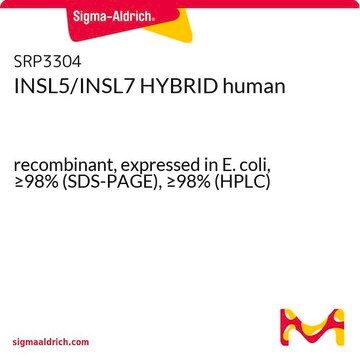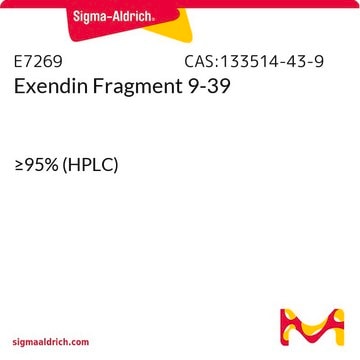SRP6233
Relaxin-3 human
recombinant, expressed in E. coli, ≥98% (SDS-PAGE)
Synonym(s):
H3 relaxin, INSL7, Insulin-like peptide-7
Sign Into View Organizational & Contract Pricing
All Photos(1)
About This Item
UNSPSC Code:
12352202
NACRES:
NA.32
Recommended Products
biological source
human
recombinant
expressed in E. coli
Assay
≥98% (SDS-PAGE)
form
lyophilized powder
mol wt
5.5 kDa
packaging
pkg of 10 μg
pkg of 50 μg
impurities
<1 EU/μg endotoxin (LAL test)
UniProt accession no.
shipped in
wet ice
storage temp.
−20°C
Gene Information
human ... RLN3(117579)
General description
RLN3 (relaxin-3) is a relaxin peptide, belonging to the insulin superfamily, with each member containing two peptide subunits linked by three disulfide bridges. This protein shows a restricted expression pattern in the brain, mainly in lateral periaqueductal gray, nucleus incertus, and central gray regions in the brainstem. This protein is highly conserved across a range of species from fish to mammals.
Biochem/physiol Actions
RLN3 (relaxin-3) functions as a ligand for the leucine-rich repeat-containing G-protein-coupled receptor (LGR), LGR7. It also acts as a ligand for orphan receptor GPCR135, or SALPR (somatostatin- and angiotensin-like peptide receptor). RLN3 acts on LGR7 resulting in stimulation of adenylate cycle; RLN3 acts on GPCR135 to prevent activation of adenylate cyclase. The RLN3–GPCR135 signaling pathway, functions alongside GABA neurotransmitter in specific brain areas, and has regulatory effects on putative GABA neuronal networks. It also interacts with pathways containing CRF (corticotrophin releasing hormone)-like peptides and their receptors. CRF-like peptides and their receptors are implicated in stress-induced autonomic and behavioral changes. RLN3–GPCR135 system is overall involved in arousal, learning and memory, stress, and locomotor activity.
Physical form
Sterile filtered through a 0.2 micron filter. Lyophilized with no additives.
Reconstitution
Centrifuge the vial prior to opening. Reconstitute in water to a concentration of 0.1-1.0 mg/mL. Do not vortex. This solution can be stored at 2-8°C for up to 1 week. For extended storage, it is recommended to further dilute in a buffer containing a carrier protein (example 0.1% BSA) and store in working aliquots at -20°C to -80°C.
Storage Class Code
11 - Combustible Solids
WGK
WGK 3
Flash Point(F)
Not applicable
Flash Point(C)
Not applicable
Certificates of Analysis (COA)
Search for Certificates of Analysis (COA) by entering the products Lot/Batch Number. Lot and Batch Numbers can be found on a product’s label following the words ‘Lot’ or ‘Batch’.
Already Own This Product?
Find documentation for the products that you have recently purchased in the Document Library.
Identification of relaxin-3/INSL7 as a ligand for GPCR142.
Liu C, et al.
The Journal of Biological Chemistry, 278(50), 50765-50770 (2003)
Central relaxin-3 administration causes hyperphagia in male Wistar rats.
McGowan BM, et al.
Endocrinology, 146(8), 3295-3300 (2005)
Relaxin-3 in GABA projection neurons of nucleus incertus suggests widespread influence on forebrain circuits via G-protein-coupled receptor-135 in the rat.
Ma S, et al.
Neuroscience, 144(1), 165-190 (2007)
Our team of scientists has experience in all areas of research including Life Science, Material Science, Chemical Synthesis, Chromatography, Analytical and many others.
Contact Technical Service






